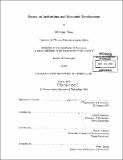Essays on institutions and economic development
Author(s)
Do, Quy Toan, 1974-
DownloadFull printable version (4.529Mb)
Other Contributors
Massachusetts Institute of Technology. Dept. of Economics.
Advisor
Abhijit Banerjee and Simon Johnson.
Terms of use
Metadata
Show full item recordAbstract
This thesis is the collection of three independent studies that analyze the interplay between institutions and economic development. In Chapter 1, I examine the relationship between wealth inequality and institutions. I present a model of regulated entry where entrepreneurs form coalitions of potentially varying size to bribe the regulator. The prevalence of capture is thus determined by the distribution of wealth. In a dynamic framework and depending on initial conditions, the economy may be either on a path towards institutional change where inequality eventually vanishes; or, it may be on a path towards institutional sclerosis, which exhibits a polarization of society into two classes with a wealthy elite dominating the increasingly impoverished masses. Chapter 2 investigates the relationship between trade and financial development. I thus present a simple model of trade in the presence of factor market imperfections. I consider an economy in which entrepreneurs undertake projects, and in doing so, contribute to the development of financial institutions. Such spillover fails to be internalized so that trade potentially induces externality losses that outweigh allocative gains. Financial markets in poorer countries deteriorate as a consequence of specialization. Static inefficiencies are exacerbated in a dynamic framework, leading poorer countries to fall into a liquidity trap. The predictions of the model suggest that trade and financial liberalization should be undertaken simultaneously and that temporary protectionist policies can be welfare improving. (cont.) Finally, Chapter 3 consists of a study I jointly did with Lakshmi Iyer, in which we look at the impact of land rights on economic outcomes. We examine the impact of a land reform in Viet Nam which gave households the power to exchange, transfer, lease, inherit and mortgage their land-use rights. We expect this change to increase incentives as well as ability to undertake long-term investments on the part of households. Our differences-in-differences estimation strategy takes advantage of the variation across provinces in the issuance of land-use certificates needed to enforce these rights. We find that the additional land rights led to significant increases in the share of total area devoted to multi-year crops, as well as some increase in irrigation investment.
Description
Thesis (Ph. D.)--Massachusetts Institute of Technology, Dept. of Economics, 2002. Includes bibliographical references.
Date issued
2002Department
Massachusetts Institute of Technology. Department of EconomicsPublisher
Massachusetts Institute of Technology
Keywords
Economics.